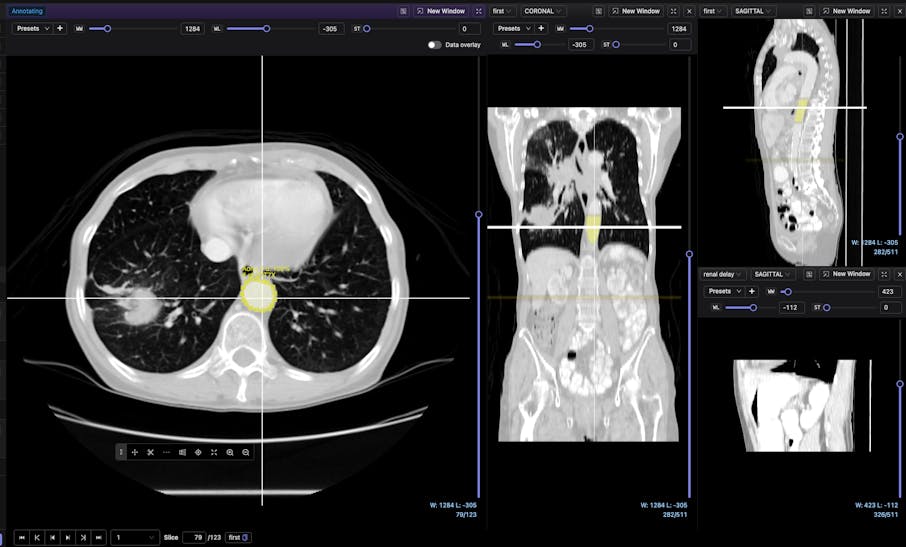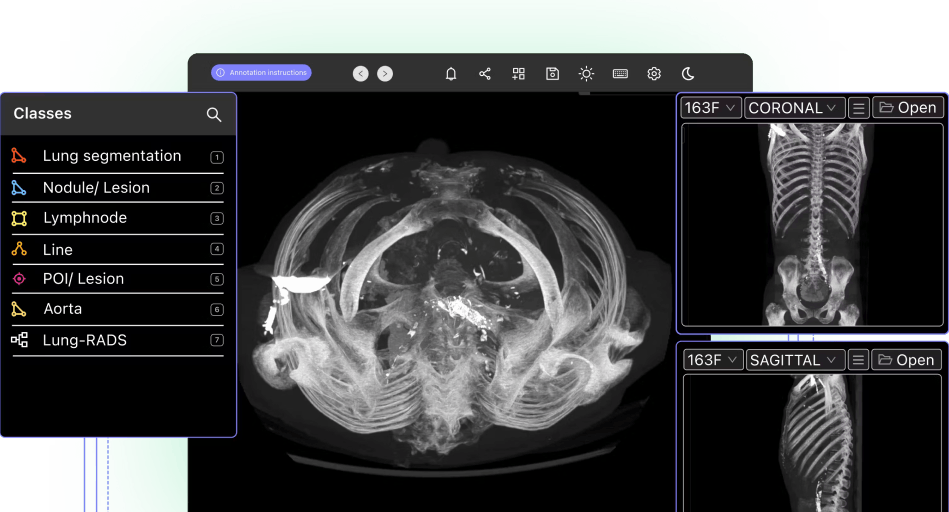Contents
Six 2024 Healthcare AI Trends
Encord Blog
The Top 6 Artificial Intelligence Healthcare Trends of 2024

One of the most exciting things about the end of the year is looking back on the progress that’s been made, and using that progress as a benchmark for making predictions about how far we might come in another year’s time.
Every year brings new technologies, new use cases, and exciting AI developments that have real-world impact. When it comes to the use of artificial intelligence in healthcare, 2023 and 2024 saw a steady increase in the number of medical diagnostic models and clinical AI tools making it into production and onto the market. We also saw an increase in the amount and quality of wearable medical devices, a heavier scrutiny of bias in machine learning, and growing privacy concerns about patient data.
With many machine learning models now having a positive impact in clinical settings, developments in healthcare AI are set to accelerate rapidly. Here are the six 2024 healthcare AI trends that we’re most excited about.

Six 2024 Healthcare AI Trends
Healthcare providers will use diagnostic artificial intelligence in fields outside of radiology
For the past few years, many AI companies have focused on developing diagnostic models for radiology.
Radiology was a logical starting place for companies and researchers looking to build diagnostic models that augment clinicians’ workloads.
Because patient screenings are standard practice in radiology, medical professionals collect and have access to a lot of data.
I spent much of my career working with breast cancer data. Healthcare providers ask women of a certain age to attend screenings at regular intervals as a preventative measure for breast cancer. At a national level, most countries also have protocols for assessing screenings, so there are standardizations within and between hospitals. Combined, these factors provided machine learning engineers with a good starting point for curating high-quality data, structuring workflows, and building models that support radiologists.
Now, machine learning engineers are starting to apply and adapt the lessons they’ve learned from radiology and build models for more complicated medical subsets. The healthcare industry is seeing a lot of AI development in microscopy, which is more challenging than radiology because pathologists have less standardization in the methods they use to count cells. Previously, this lack of standardization made it difficult to collect high-quality training data and develop a labeling protocol for annotators; however, companies such as Paige AI are starting to enter this market with technologies built to augment microscopy practices.
Likewise, Rapid AI recently received FDA approval for its stroke detection model, which is an amazing achievement because stroke detection relies on MRI data. MRI does not have standardized units, so machine learning engineers must perform manufacturer specific normalizations when collecting data to train a model.
In 2024, we’ll continue to see the use of artificial intelligence expand into different medical specialties.
The healthcare industry will focus more on healthcare rather than sick care
Rather than use AI only as a means to support a sick patient, healthcare providers will increasingly use AI to help keep patients healthy. At the same time, patients will take more ownership over monitoring their own health.
These shifting approaches toward patient care stem from the proliferation of wearable devices, a technology trend that’s been growing over the past few years. Wearables made by third-party companies are enabling users to educate themselves about their own health. Advancements in artificial intelligence are allowing these companies to analyze the data they collect at a much larger scale. As their models improve, the apps and platforms connected to at-home test kits and wearable devices are increasing patients’ ability to reliably monitor their health in real-time before they see a doctor.
In a post-pandemic world, more people have become comfortable taking ownership of their health. The use of telehealth and telemedicine, wearables, and at home-testing became increasingly common when stay-at-home orders prevented people from access to on-site healthcare providers.
Now, people feel more empowered to address their health concerns because the initial steps of testing and monitoring health no longer necessitate going to a GP, undergoing multiple on-site tests, or obtaining approval from health insurance companies for those tests.
At the same time, these companies are continuing to improve their AI’s ability to analyze the data collected, thereby providing better insights from real-time monitoring that can help doctors customize care and treatment plans. With this information, both patients and healthcare professionals can take a more proactive approach to treatment, focusing on staying healthy rather than treating sickness.
Researchers will make more datasets public to combat AI bias
Many people hope that the development of AI will help eliminate human biases by replacing human subjectivity with data-driven decision-making. However, algorithms and models are still at the mercy of the people who build and train them. Implicit biases and data collection biases can just as easily perpetuate, rather than eliminate, long-standing inequalities in medical care.
However, increasing awareness of both the historical bias in medical research and AI bias has resulted in the machine learning community paying increased attention to model bias during training and development. In doing so, ML engineers can help ensure that the machines aren’t biased toward certain demographics because of their ethnicity, age, or gender.
In an effort to combat AI bias, there’s going to be an increase in the demand for academia to develop standardized, reproducible systems. More and more journals are requiring that data sets be made public as part of the publication, which means that the research community can verify the results of a system, assess whether the data used to develop the system was balanced, and continue to iterate on and improve the system.
Startups will build more demographic-specific healthcare technology
While the machine learning community is improving the generalization of models by tackling model bias, AI startups are also tackling these longstanding biases by building demographic-specific models that generalize well for a specific population. This targeted approach necessitates a deep understanding of user needs within those demographics, making healthcare UX design a crucial element in their development process.
Rather than taking a one-size-fits-all approach to designing products, these startups are building technologies capable of generalizing only for a specific population. They have begun to develop personalized health products, segmenting customers by demographics. In doing so, they use AI to better assess and understand patient health based on demographic differences in genes, metabolism, tissue density, and other physiological factors.
For instance, some startups have designed healthcare products billed as “for Latinos by Latinos.” Others have created diet-health-focused apps that take into account lifestyle differences that impact the metabolisms of Asian populations. Others have designed skin care monitoring specifically for the LGBTQ+ community.
Such products fill an important gap for minority communities who have often suffered from mainstream medical bias in which they receive diagnoses from specialists who have deep expertise in a specific treatment area but not necessarily in diagnosing patients from diverse communities.
Differences in biology between populations often mean that a demographic-specific model is needed for patients to obtain the best treatment possible. For example, in Asian populations, women have very dense breasts. Whereas most of the world has a standard for conducting screenings with X-rays, ultrasound works much better when breasts are very dense. When building breast screening models for Asian hospitals, companies should spend more money developing specialized models that have trained on ultrasound images.
Advancements in AI are now enabling machine learning engineers to build systems that take demographic differences into account and improve patient outcomes as a result. Rather than rely on technology that caters to the greatest common denominator, new technologies will enable all patients to receive the best possible treatment method, regardless of their background, sex, lifestyle, age, or other factors.

The adoption of medical AI will accelerate the democratization of healthcare systems
Beyond the at-home monitoring made available by test kits and wearable devices, AI is going to make healthcare more accessible in remote areas as well as developing nations.
As the use of healthcare AI becomes more widespread, patients in these areas are becoming increasingly able to get access to preventative screenings via telehealth. For instance, many developing nations and rural areas don’t have enough medical experts to read the scans that they obtain during screenings. A few years ago, the size of medical images hindered the ability to have scans accessed remotely. However, the expansion of computing infrastructure – through the advent of the internet and cloud storage – as well as advances in computer science such as improvements in device memory mean that those medical images that were once too large to send remotely can now be transferred quickly from one location to another, allowing radiologists to look at samples from afar and diagnose patients in areas with limited healthcare resources, improving patient outcomes.
As this technology trend continues in the coming years, more people around the world will have access to early screenings, which will increase survival rates in regions that have been historically underserved when it comes to healthcare services.
Greater adoption of healthcare AI will increase the tension between data accessibility and data privacy
The increase in the adoption of medical AI comes with a Catch-22: we want data to be as easily accessible as possible for expert review at healthcare organizations, and we want to keep it private as possible to protect patients’ identities and other sensitive information.
Digital healthcare is becoming the norm, and even the most rigid legacy healthcare providers are undergoing digital transformations or at least using the cloud to store health records.
As more patient data is put on servers, we will see an increase in the effort to anonymize data beyond just removing names and identification numbers. Data scientists will begin to think more carefully about anonymization, considering, for instance, whether the combination of information such as a patient’s ethnicity, location, and diagnosis makes the patient identifiable.
Standardization in storage is another trend that impacts data privacy. How healthcare organizations store data has a tremendous impact on their security, which is why institutions should no longer focus on producing a solution ideal for their needs but instead focus on storing data in a standardized and secure manner.
By providing APIs and software connections that de-identify DICOM images for users, Google Health has pushed the healthcare sector in a positive direction, enabling researchers and ML engineers to use data to build and train AI without exposing a patient’s identity.
The trend of combining centralized approaches with the cloud to store data securely is a powerful one. It will continue in 2024, creating positive ripple effects for the AI ecosystem as a whole by empowering researchers to spend less time focused on data privacy tooling and more time focused on creating new methodologies and applications for medical AI.
As the healthcare industry continues to embrace artificial intelligence and other new technologies, it can create greater opportunities for patients and clinicians by increasing efficiency, creating pathways for personalized care, and improving access to treatment. At the same time, in the coming years, we’ll see machine learning engineers and healthcare providers put an increasing amount of focus on improving data privacy and reducing AI bias so that as the application of these new technologies benefits all patients.
Ready to automate and improve the quality of your medical data?
Sign-up for an Encord Free Trial: The Active Learning Platform for Computer Vision, used by the world’s leading computer vision teams.
AI-assisted labeling, model training & diagnostics, find & fix dataset errors and biases, all in one collaborative active learning platform, to get to production AI faster. Try Encord for Free Today.
Want to stay updated?
Follow us on Twitter and LinkedIn for more content on computer vision, training data, and active learning.
Join our Discord channel to chat and connect.
Explore the platform
Data infrastructure for multimodal AI
Explore product
Explore our products


